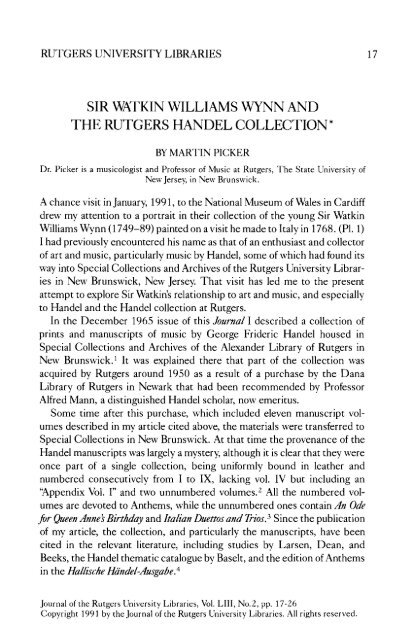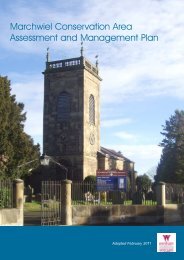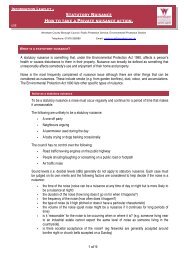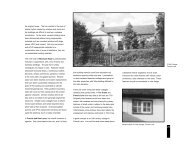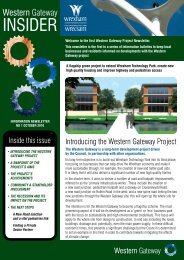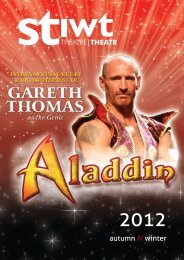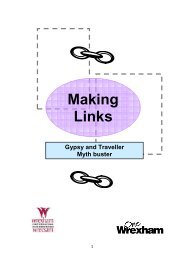sir watkin williams wynn and the rutgers handel collection
sir watkin williams wynn and the rutgers handel collection
sir watkin williams wynn and the rutgers handel collection
You also want an ePaper? Increase the reach of your titles
YUMPU automatically turns print PDFs into web optimized ePapers that Google loves.
18 THE JOURNAL OF THEIn 1975, nearly ten years after publishing my article, I received a letterfrom Graydon F. Beeks, Jr., who was <strong>the</strong>n engaged in research for hisdoctoral dissertation on H<strong>and</strong>el's Ch<strong>and</strong>os An<strong>the</strong>ms. He pointed out to methat Charles Burney, in An Account of <strong>the</strong> Musical Performance in Westminster-Abbey <strong>and</strong> <strong>the</strong> Pan<strong>the</strong>on . . . 1784 in Commemoration of H<strong>and</strong>el (London,1785), after providing a summary list of H<strong>and</strong>el's works, described someprivate <strong>collection</strong>s of music by H<strong>and</strong>el, including that of Sir Watkin WilliamsWynn. (PL 2) Burney's descriptions correspond exactly to six of <strong>the</strong> elevenvolumes of <strong>the</strong> Rutgers <strong>collection</strong>, as follows:Sir Watkin William Wynn, besides <strong>the</strong> printed OPERAS, ORATORIOS,<strong>and</strong> TE DEUMS, of HANDEL, is in possession of <strong>the</strong> following ManuscriptScores: TE DEUM in A, <strong>and</strong> <strong>the</strong> ANTHEM, "Let God arise," both transposed<strong>and</strong> altered, for <strong>the</strong> Kings Chapel. "I will magnify <strong>the</strong>e," compiled <strong>and</strong>altered, from several An<strong>the</strong>ms, for <strong>the</strong> Sons of <strong>the</strong> Clergy, at St. Paul's. ( =Appendix Vol. I; see PL 3)"As pants <strong>the</strong> hart," for five voices; with several alterations <strong>and</strong> additions, byHANDEL himself, when it was introduced in <strong>the</strong> Oratorio of ESTHER. ( =Vol. VI)"The king shall rejoice." Performed at <strong>the</strong> Chapel-Royal, on <strong>the</strong> victoryobtained at Dettingen. "Sing unto God." Performed at <strong>the</strong> nuptials of <strong>the</strong>irlate Royal Highnesses, <strong>the</strong> prince <strong>and</strong> princess of Wales, 1736. ( = Vol. VII)"Blessed are <strong>the</strong>y": partly composed, <strong>and</strong> partly compiled, for <strong>the</strong> FoundlingHospital. ( = Vol. VIII)"Let God arise," "As pants <strong>the</strong> hart." Adapted to voices, without instruments,for <strong>the</strong> Chapel Royal. ( = Vol. IX)ODE, or SERENATA, composed for <strong>the</strong> birth-day of queen Anne. ( = Vol.X) 5Because of <strong>the</strong> virtual identity of Burney's descriptions, including <strong>the</strong>order in which he lists <strong>the</strong> MSS, to volumes in <strong>the</strong> Rutgers <strong>collection</strong>, it ishighly probable that he is describing <strong>the</strong>se very ones. Their uniformity ofbinding <strong>and</strong> <strong>the</strong> appearance of <strong>the</strong> same copyists s h<strong>and</strong>s in more than onevolume strongly suggest that most if not all were in Wynn's possession in1784. It is not possible to say which of <strong>the</strong> "printed Operas, Oratorios, <strong>and</strong>Te Deums" in <strong>the</strong> Wynn <strong>collection</strong> may be represented at Rutgers, but it islikely that Rutgers possesses a substantial nucleus of its H<strong>and</strong>el material.Beeks refers to his identification of <strong>the</strong> Wynn <strong>collection</strong> at Rutgers in his1981 Berkeley dissertation <strong>and</strong> his article of <strong>the</strong> same year on <strong>the</strong> Ch<strong>and</strong>osAn<strong>the</strong>ms. 6
RUTGERS UNIVERSITY LIBRARIES 19Despite <strong>the</strong> welcome information from Dr. Beeks about <strong>the</strong> Wynn<strong>collection</strong>, I did not pursue <strong>the</strong> matter until last year, when I mounted anexhibit of early manuscript <strong>and</strong> printed music at <strong>the</strong> Alex<strong>and</strong>er Library inNew Brunswick. This exhibit included a number of items from <strong>the</strong> WynnH<strong>and</strong>el <strong>collection</strong>, among <strong>the</strong>m two volumes of An<strong>the</strong>ms (Appendix Vol. I<strong>and</strong> Vol. IX) <strong>and</strong> <strong>the</strong> Birthday Ode (Vol. X). I found it pertinent to mentionWynns role in forming <strong>the</strong> <strong>collection</strong> in <strong>the</strong> catalogue of <strong>the</strong> exhibit. 7 I alsodecided to learn more about Sir Watkin Williams Wynn. My chance visit toCardiff confirmed my decision, resulting in <strong>the</strong> present essay.Who was Sir Watkin Williams Wynn? The Dictionary of Welsh Biography(1959) informs us that <strong>the</strong> Wynn family of Wynnstay, Ruabon (Denbighshire),have been prominent Welsh l<strong>and</strong>owners distinguished in local<strong>and</strong> national affairs from <strong>the</strong> seventeenth century to <strong>the</strong> present. 8 The firstSir Watkin Williams (1692-1749) adopted <strong>the</strong> family name Wynn from hismo<strong>the</strong>rs side after succeeding to <strong>the</strong> Wynnstay estate in 1740. His son, SirWatkin Williams Wynn II (1749-89), is chiefly remembered as a patron of<strong>the</strong> arts, <strong>and</strong> it was he who owned <strong>the</strong> Rutgers H<strong>and</strong>el MSS described byBurney.The younger Watkin Williams Wynns interest in music was probablykindled in his youth <strong>and</strong> manifested itself when he was still in his teens, by<strong>the</strong> time of <strong>the</strong> portrait in Cardiff (see PL 1). In 1776, at <strong>the</strong> age of twentyseven,he was a member of a committee of noblemen in London thatestablished "The Concert of Ancient Music," a society specifically dedicatedto <strong>the</strong> performance of music written more than twenty years previously(mainly by H<strong>and</strong>el), <strong>and</strong> in 1783 he was, with Viscount Fitzwilliam<strong>and</strong> Joah Bates, an organizer of <strong>the</strong> H<strong>and</strong>el Commemoration which tookplace in London <strong>the</strong> following year, <strong>and</strong> of which he was one of <strong>the</strong>Directors. 9 He was a patron <strong>and</strong> amateur of both art <strong>and</strong> music, countingsuch artists as Reynolds <strong>and</strong> S<strong>and</strong>by among his friends, <strong>and</strong> he commissionedpaintings by Batoni, Reynolds, Mengs, <strong>and</strong> o<strong>the</strong>rs. 10His patronage of music is reflected not only in his <strong>collection</strong> of H<strong>and</strong>elmanuscripts <strong>and</strong> his role in <strong>the</strong> "Ancient Concerts" society <strong>and</strong> Commemoration,but in <strong>the</strong> fact that he had <strong>the</strong> Welsh harpist John Parry (c. 1710-82)in his employ, as had his fa<strong>the</strong>r before him. 11 H<strong>and</strong>el is said to have been anadmirer of Parry, <strong>and</strong> thus may have been acquainted with <strong>the</strong> elder Wynn. 12Whatever may have been <strong>the</strong> connection between H<strong>and</strong>el <strong>and</strong> <strong>the</strong> Wynnfamily, it is known that Parry, <strong>the</strong> most distinguished British harpist of histime, played a concerto by H<strong>and</strong>el (probably <strong>the</strong> Harp Concerto in B-flat,Op. 4, No. 6) in London in 1741. 13 Parry was also a composer of music for
20 THE JOURNAL OF THEharp <strong>and</strong> guitar, <strong>and</strong> he arranged traditional Welsh airs for <strong>the</strong> harp, publishingthree books of such arrangements in <strong>the</strong> course of his life (1742, 1761,1781). 14Sir Watkin Williams Wynn had been associated with <strong>the</strong> distinguishedmusician <strong>and</strong> music historian Dr. Charles Burney as early as 1774, whenBurney tried, unsuccessfully, to persuade <strong>the</strong> Governors of <strong>the</strong> FoundlingHospital in London (with which H<strong>and</strong>el had also been associated, <strong>and</strong> forwhich he wrote <strong>the</strong> an<strong>the</strong>m contained in vol. VIII of <strong>the</strong> Wynn H<strong>and</strong>el MSS)to transform it into a Conservatory of Music along <strong>the</strong> lines of an ItalianConservatorio. Burney's proposal led <strong>the</strong> Court of Governors to appoint aSpecial Committee "to digest <strong>and</strong> form <strong>the</strong> properest method for carrying<strong>the</strong> said plan into execution." 15 Sir Watkin, <strong>the</strong>n but twenty-five years old,was one of five gentlemen appointed to join with members of <strong>the</strong> Court indrawing up recommendations. Only two weeks later, however, <strong>the</strong> Courtdecided to reject <strong>the</strong> scheme on <strong>the</strong> grounds that <strong>the</strong> Act of Parliamentestablishing <strong>the</strong> Hospital did not allow for such a change.In a few commissions we find Sir Watkins artistic <strong>and</strong> musical interestsintertwined. The most interesting case is <strong>the</strong> decoration of <strong>the</strong> Music Roomof his London residence, designed by Robert Adam in 1773. Adams pl<strong>and</strong>escribes <strong>the</strong> panels on ei<strong>the</strong>r side of <strong>the</strong> fireplace "for pictures of St. Ceciliaetc.," <strong>and</strong> <strong>the</strong> doors of <strong>the</strong> organ cabinet were "to have Heads of greatMusicians." Over <strong>the</strong> entrance door were to be "<strong>the</strong> Muses that honour <strong>the</strong>Tomb of Orpheus," <strong>and</strong> elsewhere were to be ornamental lyres. A painting ofOrpheus by Nathaniel Dance was placed to <strong>the</strong> left of <strong>the</strong> fireplace, <strong>and</strong> oneof St. Cecilia playing a harp (clearly a reference to a traditional Welshinstrument) by Sir Joshua Reynolds (dated 1775) to <strong>the</strong> right. 16Ano<strong>the</strong>r manifestation of Wynns musical interests is contained in a tripleportrait, or "conversation piece," painted in 1768-72 by Pompeo Batoni,one of <strong>the</strong> leading Italian portrait painters of <strong>the</strong> late eighteenth century.(This is <strong>the</strong> painting in Cardiff that prompted this essay; see PL 1). At <strong>the</strong>age of nineteen, after completing his education at Oxford, Wynn was sent byhis mo<strong>the</strong>r on <strong>the</strong> "Gr<strong>and</strong> Tour," considered essential for every well-bornyoung Briton. He was accompanied by two companions, Captain EdwardHamilton <strong>and</strong> Thomas Apperley, <strong>the</strong> latter an older friend from Oxford <strong>and</strong>possibly his tutor. On arriving in Rome in 1768, Wynn engaged a musicmaster,purchased music <strong>and</strong> antiquities, arranged for private concerts, <strong>and</strong>ordered a life-sized portrait from Batoni of himself <strong>and</strong> his companions. 17 Inthis life-size painting Sir Watkin st<strong>and</strong>s on <strong>the</strong> left, holding a crayon <strong>and</strong> adrawing, evidently from his own h<strong>and</strong>, that has been identified as a copy of
RUTGERS UNIVERSITY LIBRARIES 21one of Raphaels frescoes in <strong>the</strong> Vatican palace. His soft features display hisyouth, <strong>and</strong> his paunch foreshadows his eventual corpulence. On <strong>the</strong> right isCaptain Hamilton holding a flute, representing an interest in music that heevidently shared with Sir Watkin. The seated figure in <strong>the</strong> center is Apperleywith a volume of Dante before him, which he appears to beexplicating. 18O<strong>the</strong>r Wynn portraits include a caricature by Thomas Patch made inFlorence in 1768, at about <strong>the</strong> same time as Batonis portrait. A version of it,undoubtedly exaggerated for humorous effect, shows a beefy, short-neckedSir Watkin with enormous jowls <strong>and</strong> a projecting lower lip. 19 A moreflattering <strong>and</strong> probably accurate representation is a terracotta bust byChristopher Hewetson of 1769, recognizable as <strong>the</strong> young patrician inBatonis painting. 20A drawing by <strong>the</strong> l<strong>and</strong>scape painter Paul S<strong>and</strong>by of Sir Watkin sketching(1777) offers persuasive evidence of <strong>the</strong> latter s artistic aspirations. S<strong>and</strong>byhad given Wynn lessons in drawing in 1770, <strong>and</strong> toge<strong>the</strong>r <strong>the</strong>y made severaltours of Wales for <strong>the</strong> purpose of sketching <strong>the</strong> countryside. 21 Most interestingis a group portrait by Sir Joshua Reynolds of "A Meeting of <strong>the</strong> Society ofDilettanti" (1777-79) which shows Sir Watkin, seated on <strong>the</strong> left, presidingwhile most of <strong>the</strong> o<strong>the</strong>rs raise <strong>the</strong>ir glasses in a toast to a new member, <strong>and</strong>one, with a sly smile, holds up a lady's garter in his left h<strong>and</strong>. 22 In thisconvivial painting, done a decade after Batonis portrait <strong>and</strong> <strong>the</strong> bust byHewetson, Wynn has attained <strong>the</strong> jowls <strong>and</strong> ample frame foretold by Patch.Sir Watkin Williams Wynn died in 1789, at <strong>the</strong> early age of forty. It is saidthat Mrs. Sheridan (Elizabeth Anne Linley, who married Richard BrinsleySheridan in 1773) sang to him on his deathbed. 23The fate of Sir Watkin Williams Wynns music <strong>collection</strong> is unclear, buthints can be gleaned from various sources. Most telling is A. Hyatt KingsSome British Collectors of Music c. 1600-1960 (Cambridge, 1963), whichtouches briefly on <strong>the</strong> <strong>collection</strong> built up by Wynn <strong>and</strong> continued by o<strong>the</strong>rmembers of his family. King describes a visit to Wynnstay in 1945, where hesaw <strong>the</strong> remains of <strong>the</strong> <strong>collection</strong> in a stable: "a huge mound of music ruinedby damp, but splendid even in its mouldering decay . . . Only a fraction of<strong>the</strong> pile could be rescued, as a pa<strong>the</strong>tic witness to Sir Watkirïs breadth ofmusical interests" (p. 18). His description is of printed music, <strong>and</strong> <strong>the</strong>Rutgers MSS, which are in relatively good condition, may have alreadypassed to o<strong>the</strong>r h<strong>and</strong>s. This is implied by a list of dispersed <strong>collection</strong>s at <strong>the</strong>end of Kings book, in which that of Sir Watkin Williams Wynn, Bart, is
Pl. 1. Pompeo Batoni (1708-1787), Portrait of Sir Watkin Williams Wynn, Bart.,Thomas Apperley <strong>and</strong> Captain Edward Hamilton. Oil on canvas, signed <strong>and</strong> dated1768. National Museum of Wales, Cardiff.
utaiO£coJMQ£ î o•3U3G Un 10 OS.f* ic lCl,1 ? °IifcoË- -S *• -gL -So ~aL i-OHi; î{CSÛH•c •à• ^>3 O O 'Su ~3 -5 "S o -a fcI « w§ £L) L>,•feoScj^ T3 v,Clq t>û cq O ^£S £.S ^S 8,'•a i•S H
Pl. 3. MS, "An<strong>the</strong>ms Composed by Mr. H<strong>and</strong>el, Appendix Vol. I." Rutgers UniversityLibraries, Special Collections <strong>and</strong> Archives, x Fo. M2038.H14A5, v.2. Table ofContents <strong>and</strong> p. 1.
Pl. 4. Flyleaf. Six Concertos For <strong>the</strong> Harpsicord or Organ Composé by Mr. H<strong>and</strong>el(London, c. 1750). Rutgers University Libraries, Special Collections <strong>and</strong>Archives, x Fo. M.H236S. Gift of Mrs. Charles C. Hommann, Jr., in memoryof Charles C. Hommann, Jr., Class of 1910.
sH a r p l i c o r c l o r O r a a nC O M P O S D B Y, M M A N D E L .r / u Je , A i {•û/hYsZcKf /rï/rl^Ms/t') / w M ? / f c / j / S//v//i ///
22 THE JOURNAL OF THEdescribed as having been dispersed in <strong>the</strong> "early twentieth century" (p.148).A few o<strong>the</strong>r remnants of Wynns music <strong>collection</strong> besides <strong>the</strong> manuscriptsat Rutgers have been traced by Graydon Beeks. 24 These include unboundvolumes of H<strong>and</strong>el an<strong>the</strong>ms in <strong>the</strong> <strong>collection</strong> of Gerald Coke in Hampshire,<strong>and</strong> a manuscript of Italian cantatas by H<strong>and</strong>el as well as early editions of hisoperas at <strong>the</strong> University of Sydney, Australia. Wynn owned contemporarymusic too; a manuscript of opera excerpts by Piccini, Monza, <strong>and</strong> Gassmanfrom his <strong>collection</strong> is at St. Michaels College, Tenbury. As recently as 1988a manuscript of Part 2 of H<strong>and</strong>el's Messiah bearing <strong>the</strong> Wynn emblem turnedup near Manchester. 25By whatever means <strong>the</strong> H<strong>and</strong>el MSS came to Rutgers, <strong>the</strong>y remaineloquent testimony to Sir Watkins love of music <strong>and</strong> collecting. It gives mepleasure to draw <strong>the</strong> attention of readers of this Journal to <strong>the</strong>ir formerowner, a distinguished eighteenth-century Welsh collector <strong>and</strong> patronwhose memory is enshrined in <strong>the</strong> substantial remnant of his library thatsurvives at Rutgers.PostscriptOne of <strong>the</strong> H<strong>and</strong>el volumes at Rutgers {not from <strong>the</strong> Wynn <strong>collection</strong>,however) is of special interest for its American associations. This is a printedvolume containing H<strong>and</strong>el's Six Concertos for <strong>the</strong> Harpsicord or Organ (Op. 4),London: J. Walsh, c.1750, bound with A Second Set of Six Concertos.. . (1740), once owned by Rayner Taylor (b. London 1747, d.Philadelphia 1825). 26 Taylor was a choirboy in <strong>the</strong> Chapel Royal <strong>and</strong> is saidto have been present at H<strong>and</strong>el's funeral. 27 As an adult musician he served asorganist at Chelmsford <strong>and</strong> composed for <strong>the</strong> London stage. In 1792 heemigrated to America, settling in Philadelphia <strong>the</strong> following year. Active forover three decades in Philadelphia as organist, singer, composer, <strong>and</strong>teacher, Taylor left a profound mark on American musical life during <strong>the</strong>Federal period. 28The flyleaf of <strong>the</strong> volume in question bears <strong>the</strong> inscription "HommannJunr. A Gift from his Preceptor <strong>and</strong> Friend Rayner Taylor, Mus. Doc.August, 1820." (PL 4) On <strong>the</strong> title page <strong>the</strong> name "Mr. Taylor" has beenscratched out <strong>and</strong> "Hommann Jr." written below it. (PL 5) The cover of <strong>the</strong>volume is imprinted "J. C. Hommann Junr." John C. Hommann (senior) wasa German musician who immigrated to Philadephia in <strong>the</strong> 1790s. He hadtwo sons, John Jr. <strong>and</strong> Charles, <strong>the</strong> latter of whom was a noted composer <strong>and</strong>teacher in nineteenth-century Philadelphia (d. after 1862). 29
RUTGERS UNIVERSITY LIBRARIES 23All three members of <strong>the</strong> Hommann family were active as violinists inPhiladelphia before 1820 <strong>and</strong> continued to perform in concerts sponsoredby <strong>the</strong> Musical Fund Society after it was founded in that year. The Society'sfirst Directors of Music included Rayner Taylor, Benjamin Carr, <strong>and</strong> a dozeno<strong>the</strong>rs, including J. C. Hommann; Hommann Jr. is listed among its members.30 The three Hommanns performed at <strong>the</strong> first concert of <strong>the</strong> Society(1821), an extraordinary program of symphonies, overtures, concertos,songs, <strong>and</strong> choruses, including overtures by Rossini <strong>and</strong> Mehul, <strong>and</strong>Beethoven's "Gr<strong>and</strong> Sinfonia in C" (probably <strong>the</strong> First Symphony ra<strong>the</strong>r than<strong>the</strong> Fifth). 31 The H<strong>and</strong>el concerto volume (given to Rutgers by Mrs.Charles C. Hommann, Jr., in memory of her husb<strong>and</strong>, Rutgers College classof 1910) thus represents an au<strong>the</strong>ntic link between H<strong>and</strong>el, his distinguishedAnglo-American follower Rayner Taylor, <strong>and</strong> <strong>the</strong> latter s studentJ. C. Hommann, Jr., by <strong>the</strong> generosity of whose family <strong>the</strong> volume waseventually given to <strong>the</strong> Rutgers Library.* This essay is respectfully dedicated to Professor Sir David G.T. Williams, President ofWolfson College, Cambridge, <strong>and</strong> Vice Chancellor of <strong>the</strong> University of Cambridge.Notes1 "H<strong>and</strong>eliana in <strong>the</strong> Rutgers University Library," in The Journal of <strong>the</strong> Rutgers UniversityLibrary, 29 (1965): 3-12.2 The call number of <strong>the</strong> nine MS volumes in <strong>the</strong> Rutgers <strong>collection</strong> is X Fo.M2038.H14A5. v. 1 (-9).3 The call numbers of <strong>the</strong>se volumes are X Fo. M1510.H 14033 <strong>and</strong> X Fo.M1529.H14I8, respectively.4 Jens Peter Larsen, H<strong>and</strong>el's Messiah, 2nd ed. (New York, 1972), pp. 326-27; WintonDean <strong>and</strong> Anthony Hicks, "H<strong>and</strong>el," in The New Grove Dictionary of Music <strong>and</strong> Musicians, ed.Stanley Sadie (London, 1980), 8:83-140; Graydon F. Beeks, "The Ch<strong>and</strong>os An<strong>the</strong>ms<strong>and</strong> Te Deum of George Frideric H<strong>and</strong>el (1685-1759)," (Ph.D. diss., University ofCalifornia at Berkeley, 1981), pp. 253-73; idem, "H<strong>and</strong>el's Ch<strong>and</strong>os An<strong>the</strong>ms: The 'ExtraMovements," Musical Times, 119 (1978): 621-23; idem, "H<strong>and</strong>el's Ch<strong>and</strong>os An<strong>the</strong>ms:More 'Extra Movements," Music & Letters, 62 (1981): 155-61; Bernd Baselt, Hàndel-H<strong>and</strong>buch, Bd. 2, Thematisch-systematisches Verzeichnis: Oratorisch Werke, Vokale Kammermusik,Kirchenmusik (Kassel, 1984), pp. 440ff, 605ff, 680ff; Hallische Hândel-Ausgabe, Ser.Ill, Bd. 4-6, An<strong>the</strong>ms fur Cannons I-III, ed. Gerald Hendrie (Kassel, 1985- ).For reference purposes, it will be useful here to list <strong>the</strong> contents of <strong>the</strong> Rutgers MSSaccording to <strong>the</strong> numbers assigned in <strong>the</strong> Baselt Verzeichnis (HWV):(1) An<strong>the</strong>ms, vol. I (HWV 281). (2) An<strong>the</strong>ms, Appendix vol. I (HWV 282, 256b, 250b).(3) An<strong>the</strong>ms, vol. II (HWV 248, 253). (4) An<strong>the</strong>ms, vol. Ill (HWV 249b, 251b). (5)
24 THE JOURNAL OF THEAn<strong>the</strong>ms, vol. V (HWV 250a, 252). (6) An<strong>the</strong>ms, vol. VI (HWV 251c, 254). (7) An<strong>the</strong>ms,vol. VII (HWV 265, 263). (8) An<strong>the</strong>ms, vol. VIII (HWV 268). (9) An<strong>the</strong>ms, vol. IX (HWV256a, 251a). (10) An Ode for Queen Anne's Birth-Day (HWV 74). (11) Italian Duettos<strong>and</strong> Trios (HWV 178, 180, 183-85, 188, 191, 193, 194, 196-201).5 Charles Burney, An Account of <strong>the</strong> Musical Performances . . . (London, 1785; reprint,Amsterdam, 1964), part I, pp. 45-46.1 have altered <strong>the</strong> format of <strong>the</strong> original descriptionsin order to clarify <strong>the</strong>ir relationship to <strong>the</strong> Rutgers MSS. Originally <strong>the</strong> sentencesdescribing each work were indented as separate paragraphs. (See PI. 2)6 "The Ch<strong>and</strong>os An<strong>the</strong>ms <strong>and</strong> Te Deum of George Frideric H<strong>and</strong>el," p. 253, <strong>and</strong>"H<strong>and</strong>el's Ch<strong>and</strong>os An<strong>the</strong>ms: More 'Extra Movements," p. 157.7 Music of Eight Centuries. Musical Documents c.l000-c.l800. September 23 throughDecember 14, 1990. Gallery 50, Special Collections <strong>and</strong> Archives, Alex<strong>and</strong>er Library.The H<strong>and</strong>el MSS are no. 31 in <strong>the</strong> catalogue, which contains a facsimile of <strong>the</strong> openingpage of <strong>the</strong> Birthday Ode.8 E.G. Jones, "Wynn family of Wynnstay, Ruabon," in The Dictionary of Welsh Biographydown to 1940, ed. J.E. Lloyd <strong>and</strong> R.T. Jenkins (London, 1959), p. 1100.9 Charles Mackeson, "Ancient Concerts," Grove's Dictionary of Music <strong>and</strong> Musicians, 2nded., ed. by J.A. Fuller-Maitl<strong>and</strong> (London, 1904, 1:81-82; reprinted in subsequent eds.including 5th ed., ed. by Eric Blom (London, 1954), 1:144-45; Burney, An Account of <strong>the</strong>Musical Performances, Commemoration, pp. 3, 17.10 Brinsley Ford, "Sir Watkin Williams-Wynn, A Welsh Maecenas," Apollo, 99 (June,1974): 435-39, offers an illustrated survey of Wynns patronage of art <strong>and</strong> artists.11 R.D. Griffith, "Parry, John ('The Blind Harpist')", The Dictionary of Welsh Biography,p. 735; Owain Edwards, "Parry, John (i)," The New Grove, 14:245.12 The statement that Parry is said to have been admired by H<strong>and</strong>el is made in <strong>the</strong>article by W.H. Husk, "Parry, John," in Grove's Dictionary of Music <strong>and</strong> Musicians, 2nd ed.,ed. J.A. Fuller-Maitl<strong>and</strong> (London, 1904), 3:627, <strong>and</strong> subsequent editions. The samestatement is found in <strong>the</strong> revised article by Peter Crossley-Holl<strong>and</strong> in <strong>the</strong> 5th ed. (1954),6:565f.13 London Daily Post, 27 February 1741; cited in Otto Erich Deutsch, H<strong>and</strong>el, ADocumentary Biography (London, 1955), p. 512.14 Edwards, "Parry," in The New Grove, 14:245.15 Percy A. Scholes, The Great Dr. Burney {London, 1948), 1:262.16 The painting, purchased at <strong>the</strong> Wynn sale at So<strong>the</strong>by's in 1947 by William R<strong>and</strong>olphHearst <strong>and</strong> given by him to <strong>the</strong> Los Angeles County Museum, is reproduced <strong>and</strong> itsbackground described by Nicholas Penny in <strong>the</strong> splendid Reynolds catalogue of <strong>the</strong> RoyalAcademy of Arts (London, 1980), pp. 266-68. Also to be seen <strong>the</strong>re is a photograph of <strong>the</strong>Music Room of <strong>the</strong> Wynn house on St. James Square. Penny describes Wynn as "probably
RUTGERS UNIVERSITY LIBRARIES 25<strong>the</strong> most munificent patron of music <strong>and</strong> painting in Britain in <strong>the</strong> last twenty years of hislife."17 See Ford, "Sir Watkin Williams-Wynn," pp. 435-36. Although dated 1768, <strong>the</strong>painting was not completed until 1772. It is now in <strong>the</strong> National Museum of Wales, Cardiff,having been purchased at <strong>the</strong> Wynn sale in 1947.18 See Anthony M. Clark, Pompeo Batoni, A Complete Catalogue of his Works with anIntroductory Text (Oxford, 1985), pp. 323-25 <strong>and</strong> plate 316; <strong>and</strong> Steve Race, Music withPaintings from <strong>the</strong> art galleries of <strong>the</strong> National Museum of Wales (Cardiff, 1980), side 2, b<strong>and</strong>s1-2 (record <strong>and</strong> book).19 Ford, "Sir Watkin Williams-Wynn," pp. 435 (fig. 1), 436.20 Ford, pp. 435, 437 (fig. 5).21 Peter Hughes, "Paul S<strong>and</strong>by <strong>and</strong> Sir Watkin Williams-Wynn," The Burlington Magazine,114 (July 1972): 459-66; <strong>the</strong> drawing of Wynn appears on p. 461, fig. 21.22 Ford, p. 439 (fig. 7); Penny, Reynolds, pp. 138 (fig. 109), 281-82; Ellis Waterhouse,Reynolds (London, 1973), p. 29 <strong>and</strong> plate 81.23 Ford, p. 439. Reynolds painted a portrait of Mrs. Sheridan as St. Cecilia seated at <strong>the</strong>organ; see Penny, Reynolds, pp. 265-66 (fig. 94). Burney expressed his admiration for Mrs.Sheridan, calling her "an exquisite <strong>and</strong> darling singer" (Account, part I, p. 24n).24 "The Ch<strong>and</strong>os An<strong>the</strong>ms <strong>and</strong> Te Deum of George Frideric H<strong>and</strong>el," pp. 253-55.25 Donald Burrows, "Newly-recovered Messiah Scores," Newsletter of The AmericanH<strong>and</strong>el Society, 4/3 (Dec., 1989): 1-5.26 The volume is described in Picker, "H<strong>and</strong>eliana," p. 2, with <strong>the</strong> call number x Fo.M.H236S. That article, however, does not mention <strong>the</strong> inscription on <strong>the</strong> flyleaf identifying<strong>the</strong> volume as having been given as a gift by "Rayner Taylor, Mus. Doc." in August1820. The complete inscription is quoted in my exhibition catalogue, Music of EightCenturies, no. 46, <strong>and</strong> in <strong>the</strong> next paragraph of <strong>the</strong> present article.A thorough, well-documented biography of Taylor is given in an article by Victor FellYellin, "Rayner Taylor," American Music 1 (No. 3, Fall 1983): 48-71. Yellin establishes <strong>the</strong>correct spelling of Taylor's first name as "Rayner," not "Raynor," <strong>the</strong> spelling that mostreference works give. The inscription in Rutgers's H<strong>and</strong>el volume also has "Rayner,"probably in his own h<strong>and</strong>.27 An oft-repeated anecdote, supposedly told by Taylor himself, is that his hat accidentallyfell into H<strong>and</strong>el's grave <strong>and</strong> was buried with <strong>the</strong> remains of <strong>the</strong> great composer. SeeLouis C. Madeira, Annals of Music in Philadelphia <strong>and</strong> History of <strong>the</strong> Musical Fund Society, ed.Philip H. Goepp (Philadelphia, 1896; reprinted New York, 1973), p. 52.28 In addition to writing <strong>the</strong> article cited above, Yellin summarizes Taylor's biography ina brief article, "Taylor, Rayner," The New Grove Dictionary of American Music, ed. H. WileyHitchcock <strong>and</strong> Stanley Sadie (London, 1986), 4:358. Valuable information dating fromTaylor's lifetime is contained in John Rowe Parker, A Musical Biography: or, Sketches of <strong>the</strong>
26 THE JOURNAL OF THELives <strong>and</strong> Writings of Eminent Musical Characters (Boston, 1825; reprint Detroit, 1975,with a new introduction by Frederick Freedman), pp. 179-82 ("Rayner Taylor").29 See Karl Kroeger <strong>and</strong> Richard Claypool, "Hommann, Charles," The New GroveDictionary of American Music, 2:416.30 Madeira, Annals, p. 60.31 Madeira, pp. 70-76.


